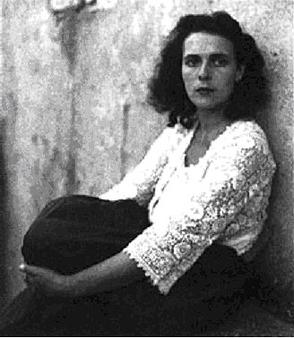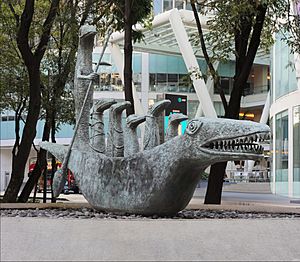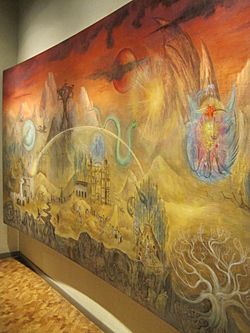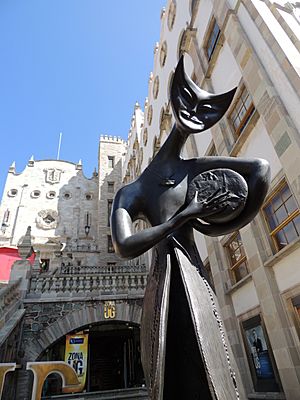Leonora Carrington facts for kids
Quick facts for kids
Leonora Carrington
|
|
|---|---|
 |
|
| Born | 6 April 1917 |
| Died | 25 May 2011 (aged 94) Mexico City, Mexico
|
| Known for | Painting Writing |
| Movement | Surrealism |
| Spouse(s) | Renato Leduc Emerico "Chiki" Weisz |
| Children | Gabriel and Pablo Weisz |
Mary Leonora Carrington OBE (6 April 1917 – 25 May 2011) was a British-born surrealist painter and novelist. She lived most of her adult life in Mexico City and was one of the last surviving participants in the surrealist movement of the 1930s. Carrington was also a founding member of the women's liberation movement in Mexico during the 1970s.
Contents
Early life
Mary Leonora Carrington was born at Westwood House in Clayton Green, England, into a Roman Catholic family. Her father, Harold Wylde Carrington, was a wealthy textile manufacturer, and her mother, Marie (née Moorhead), was from Ireland. She had three brothers: Patrick, Gerald, and Arthur. She lived at Crookhey Hall from 1920 until 1927, a large home in Cockerham, which exerted a great influence on her imagination.
Educated by governesses, tutors, and nuns, she was expelled from two schools, including New Hall School in Chelmsford for her rebellious behaviour, until her family sent her to Florence, where she attended Mrs Penrose's Academy of Art. She also, briefly, attended St Mary's convent school in Ascot. In 1927, at the age of ten, she saw her first Surrealist painting in a Left Bank gallery in Paris and later met many Surrealists, including Paul Éluard. Her father opposed her career as an artist, but her mother encouraged her. She returned to England and was presented at Court, but according to her, she brought a copy of Aldous Huxley's Eyeless in Gaza (1936) to read instead. In 1935, she attended the Chelsea School of Art in London for one year, and with the help of her father's friend Serge Chermayeff, she was able to transfer to the Ozenfant Academy of Fine Arts established by the French modernist Amédée Ozenfant in London (1936–38).
She became familiar with Surrealism from a copy of Herbert Read's book, Surrealism (1936), given to her by her mother, but she received little encouragement from her family to forge an artistic career. The Surrealist poet and patron Edward James was the champion of her work in Britain; James bought many of her paintings and arranged a show in 1947 for her work at the Pierre Matisse Gallery in New York. Some works are still hanging at James' former family home, currently West Dean College in West Dean, West Sussex.
Association with Max Ernst
In 1936 Carrington saw the work of the German surrealist Max Ernst at the International Surrealist Exhibition in London and was attracted to the Surrealist artist before she even met him. In 1937 Carrington met Ernst at a party held in London. The artists bonded and returned together to Paris, where Ernst promptly separated from his wife. In 1938 they left Paris and settled in Saint Martin d'Ardèche in southern France. The new couple collaborated and supported each other's artistic development. The two artists created sculptures of guardian animals (Ernst created his birds and Carrington created a plaster horse head) to decorate their home in Saint Martin d'Ardèche. In 1939 Carrington and Ernst painted portraits of each other. Both capture the ambivalence in their relationship, but whereas Ernst's The Triumph of Love features both artists in the composition, Carrington's Portrait of Max Ernst focused solely on Ernst and is laced with heavy symbolisms. The portrait was not her first Surrealist work; between 1937 and 1938 Carrington painted Self-Portrait, also called The Inn of the Dawn Horse, now exhibited at the Metropolitan Museum of Art. Sporting white jodhpurs and a wild mane of hair, Carrington is perched on the edge of a chair in this curious, dreamlike scene, her hand outstretched toward a prancing hyena and her back to a tailless rocking horse flying behind her.
With the outbreak of World War II Ernst, who was German, was arrested by the French authorities for being a "hostile alien". With the intercession of Paul Éluard, and other friends, including the American journalist Varian Fry, he was discharged a few weeks later. Soon after the Nazis invaded France, Ernst was arrested again, this time by the Gestapo, because his art was considered by the Nazis to be "degenerate". He managed to escape and flee to the United States with the help of Peggy Guggenheim, who was a sponsor of the arts.
After Ernst's arrest Carrington was devastated and agreed to go to Spain with a friend, Catherine Yarrow. She stayed with family friends in Madrid until her paralyzing anxiety and delusions led to a psychotic break and she was admitted into an asylum. She was released from the asylum into the care of a keeper, and was told that her parents had decided to send her to a sanatorium in South Africa. En route to South Africa, she stopped in Portugal, where she made her escape. She went to the Mexican Embassy to find Renato Leduc, a poet and Mexican Ambassador. Leduc was a friend of Pablo Picasso (they knew each other from bull fights) and agreed to a marriage of convenience with Carrington so that she would be accorded the immunity given to a diplomat's wife. The pair divorced in 1943. Meanwhile, Ernst had married Peggy Guggenheim in New York in 1941. That marriage ended a few years later. Ernst and Carrington never resumed their relationship.
Mexico
After spending a year in New York, Leduc and Carrington went to Mexico, where many European artists fled in search of asylum, in 1942, which she grew to love and where she lived, on and off, for the rest of her life.
When Carrington first came to Mexico she was preceded by the success of surrealist exhibitions which allowed her to create many connections within the surrealist movement. Her connections within these surrealist circles were influential in opening artistic doors that had long been closed to Mexican artists. After living in Mexico for seven years, Leonora Carrington held her first solo exhibition at the Galeria Clardecor. Much of the initial response from the public was very encouraging, and the press for months following published positive and approving critic reviews.
After spending part of the 1960s in New York City, Carrington lived and worked in Mexico once again. While in Mexico she was asked, in 1963, to create a mural which she named El Mundo Magico de los Mayas, and which was influenced by folk stories from the region. The mural is now located in the Museo Nacional de Antropología in Mexico City.
In 1973 Carrington designed Mujeres conciencia, a poster for the Women's Liberation movement in Mexico, depicting a 'new Eve'. In the 1970s women artists of previous waves and generations responded to the more liberal climate and movement of the array of feminist waves. Many pushed the issues of women's liberation and consciousness within their work while others spoke out on issues instead of making art. She frequently spoke about women’s “legendary powers” and the need for women to take back “the rights that belonged to them.” Many artists involved in the Surrealism regarded women to be useful as muses but not seen as artists in their own right. Carrington was adopted as a femme-enfant by the Surrealists because of her rebelliousness against her upper-class upbringing.
Carrington primarily focused on psychic freedom in the belief that such freedom cannot be achieved until political freedom is also accomplished. Through these beliefs Carrington understood that "greater cooperation and sharing of knowledge between politically active women in Mexico and North America" was important for emancipation. Carrington's political commitment led to her winning the Lifetime Achievement Award at the Women's Caucus for Art convention in New York in 1986. Throughout the decade women identified and defined an array of relationships to feminist and mainstream concepts and concerns. Continuing through the decade women continued to question the meaning of existence through form and material.
I didn't have time to be anyone's muse... I was too busy rebelling against my family and learning to be an artist.
—Leonora Carrington
Second marriage and children
She later married Emerico Weisz (nicknamed "Chiki"), born in Hungary in 1911, a photographer and the darkroom manager for Robert Capa during the Spanish Civil War. Together they had two sons: Gabriel, an intellectual and poet, and Pablo, a doctor and Surrealist artist. Chiki Weisz died 17 January 2007, at home. He was 97 years old.
Death
Leonora Carrington died on 25 May 2011, aged 94, in a hospital in Mexico City as a result of complications arising from pneumonia. Her remains were buried at Panteón Inglés (English Cemetery) in Mexico City.
Themes and major works
Carrington stated that: "I painted for myself...I never believed anyone would exhibit or buy my work." She was not interested in the writings of Sigmund Freud, as were other Surrealists in the movement. She instead focused on magical realism and alchemy and used autobiographical detail and symbolism as the subjects of her paintings. Carrington's work of the 1940s is focused on the underlying theme of women's role in the creative process.
Carrington's work is identified and compared with the surrealist movement. Within the surrealist movement, there was a strong exploration of the women's body combined with the mysterious forces of nature.
When painting, she used small brushstroke techniques building up layers in a meticulous manner, creating rich imagery.
In Self-Portrait (1938) Carrington explores the duality that comes with being a woman. This concept of duality is explored by Carrington using a mirror to assert duality of the self and the self being an observer with being observed. The hyena depicted in Self-Portrait (1937–38) joins both male and female into a whole, metaphoric of the worlds of the night and the dream. The symbol of the hyena is present in many of Carrington's later works, including "La Debutante" in her book of short stories The Oval Lady.
Carrington had an interest in animals, myth, and symbolism. This interest became stronger after she moved to Mexico and started a relationship with the émigré Spanish artist Remedios Varo. The two studied alchemy, the kabbalah, and the post-classic Mayan mystical writings, Popol Vuh.
The first important exhibition of her work appeared in 1947 at the Pierre Matisse Gallery in New York City. Carrington was invited to show her work in an international exhibition of Surrealism, where she was the only female English professional painter. She became a celebrity almost overnight. In Mexico, she authored and successfully published several books.
The first major exhibition of her work in UK for twenty years took place at Chichester's Pallant House Gallery, West Sussex, from 17 June to 12 September 2010, and subsequently in Norwich at the Sainsbury Centre for Visual Arts, as part of a season of major international exhibitions called Surreal Friends that celebrated women's role in the Surrealist movement. Her work was exhibited alongside pieces by her close friends, the Spanish painter Remedios Varo (1908–1963) and the Hungarian photographer Kati Horna (1912–2000).
In 2013 Carrington was the subject of a major retrospective at the Irish Museum of Modern Art, Dublin. Titled The Celtic Surrealist, it was curated by Sean Kissane and examined Carrington's Irish background to illuminate many cultural, political and mythological themes present in her work.
Carrington's art often depicts horses, as in her Self-Portrait (Inn of the Dawn Horse) and the painting The Horses of Lord Candlestick. Her fascination with drawing horses began in her childhood. Horses also appear in her writings. In her first published short story, "The House of Fear", Carrington portrays a horse in the role of a psychic guide to a young heroine. In 1935, Carrington's first essay, "Jezzamathatics or Introduction to the Wonderful Process of Painting", was published before her story "The Seventh Horse". Carrington often used codes of words to dictate interpretation in her artwork. "Candlestick" is a code that she commonly used to represent her family, and the word "lord" for her father.
Carrington contributed to the 1973 Mexican horror film The Mansion of Madness directed by Juan López Moctezuma, loosely based on the Edgar Allan Poe short story The System of Doctor Tarr and Professor Fether. She supervised the artistic design for the sets and costumes, with one of her sons, Gabriel Weisz. The repeated appearance of a white horse, Carrington's alter ego, and the elaborate surreal feasts and costumes show her influence and vision.
In 2005 Christie's auctioned Carrington's Juggler (El Juglar), and the realised price was US$713,000, setting a new record for the highest price paid at auction for a living surrealist painter. Carrington painted portraits of the telenovela actor Enrique Álvarez Félix, son of actress María Félix, a friend of Carrington's first husband.
In 2015, Carrington was honoured through a Google Doodle commemorating her 98th birthday. The Doodle was based on her painting, How Doth the Little Crocodile, drawn in surrealist style. The painting was inspired by a poem in Lewis Carroll's Alice's Adventures in Wonderland, and this painting was eventually turned into Cocodrilo located on Paseo de la Reforma.
Legacy and influence
Carrington is credited with feminising surrealism. Her paintings and writing brought a woman’s perspective to what had otherwise been a largely male-dominated artistic movement. Carrington demonstrated that women should be seen as artists in their own right and not to be used as muses by male artists.
The 59th International Art Exhibition will be titled The Milk of Dreams. This name is borrowed from a book by Carrington, in which, as Cecilia Alemani says she, “describes a magical world where life is constantly re-envisioned through the prism of the imagination, and where everyone can change, be transformed, become something and someone else.”
Carrington’s life inspired "Out of This World: The Surreal Art of Leonora Carrington", a children's nonfiction book written by Michelle Markell and illustrated by Amanda Hall and which tells the story of Carrington’s life and art as she pursues her creative talents and breaks with 20-century conventions about the ways in which an upper-class women and debutants should behave.
Artworks
- Self-Portrait (Inn of the Dawn Horse), 1936–1937, The Metropolitan Museum of Art, The Pierre and Maria-Gaetana Matisse Collection
- The Horses of Lord Candlestick, 1938 (private collection)
- The Meal of Lord Candlestick, 1938
- Portrait of Max Ernst, c. 1939, Scottish National Gallery of Modern Art
- The Temptation of St. Anthony, 1945 (private collection)
- The Kitchen Garden on the Eyot, 1946, San Francisco Museum of Modern Art
- The Giantess (The Guardian of the Egg), 1947 (private collection)
- The Old Maids, 1947, Sainsbury Centre for Visual Arts University of East Anglia
- The Bird Bath, 1974
- The Memory Tower, 1995, The Viktor Wynd Museum of Curiosities, Fine Art & Natural History, London
- Gatomaquia, 2009, Museo Leonora Carrington, Mexico
See also
 In Spanish: Leonora Carrington para niños
In Spanish: Leonora Carrington para niños
- Women Surrealists




